How Far Should You Hit a Driver? FULL GUIDE By Age, Handicap etc.
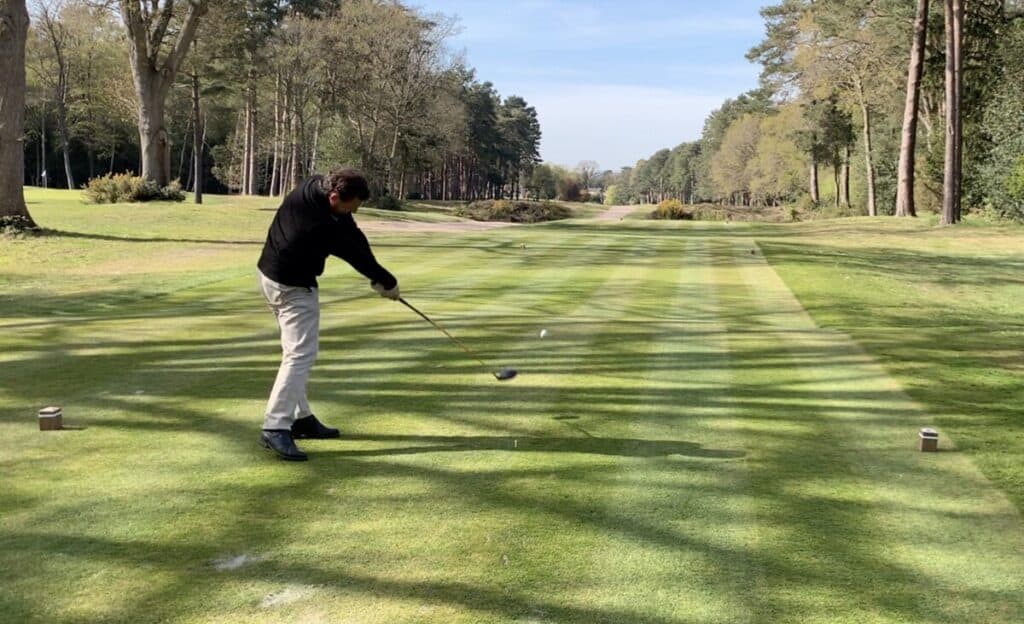
Human beings love to make and watch things fly and hitting and watching a golf ball soaring into the distance is no different.
Comparing how far you hit a driver is therefore a much enjoyed pastime among amateur golfers and thanks to all of the advances in modern golf technology it is now possible to have an almost exact idea where your driving distance sits in relation to your peers.
In total the average male golfer hits a driver 219 yards according to the analysis of 15.7 million shots by Arccos. 20 to 29 years olds, and 0 to 5 handicapped golfers, hit the furthest driving 239.7 yards and 242.6 yards on average respectively. The average amateur women golfer hits their driver 166.4 yards in total.
As every amateur golfer knows however the topic of distance and how far you hit a driver is not a simple question.
The fact that individuals themselves can drive the ball a variety of distances in any one round is itself evidence of how complicated and multi-dimensional the question is.
So in the remainder of this article we look at the topic in its entirety and pore over the data of how far the average golfer should hit a driver broken down by a number of categories including age, handicap and swing speed to give you a better idea of how good your driving is.
[Top tip: Improving your fitness and swing speed will make a huge difference to how far you hit the ball and has the potential to add 20 to 30 yards to drives and an extra club throughout the bag. If you want to know how you can achieve this check out two of the best ‘golf training’ programs that can get you there:
- The Stack System
- Fit for Golf (Use discount code GOLFINGFOCUS20 for 20% off annual subscriptions!)
How Far Should the Average Golfer Hit a Driver? The Good & Bad
Knowing how far you should hit your driver and whether the distance you are getting is good or bad depends on a lot of things.
What one golfer considers to be a good distance to hit a drive can clearly be very different to what another player thinks is a good drive.
And spend much time on YouTube and you would be forgiven for becoming convinced that the vast majority of regular amateur golfers hit the ball further than 300 yards on average!
However thanks to automatic golf tracking platforms such as Arccos, golf’s first Artificial Intelligence system, amateurs can now at least have a very clear idea of how common it is for golfers to drive the ball certain distances.
Over the course of three years Arccos crunched the numbers of over 29.4 million drives hit by amateurs, calculated the median distance (i.e the midpoint) all players hit their driver to limit the impact of the truly exceptional good and especially bad shots, and analysed what percentage of amateurs hit the ball specific distances.
On average only 0.1% of male amateurs drive the ball over 300 yards showing how uncommon it is. 0.5% of golfers have a median driving distance of 290 yards, 1.5% hit over 280 yards, 3.9% drive over 270 yards with still only 15.5% hitting drives more than 250 yards. Almost 25% of amateurs drive the ball less than 200 yards.
A complete breakdown of the Arccos data and the cumulative total percentages of how many golfers drive the ball specific distances are detailed in the table below.
| TOTAL DRIVING DISTANCE | TOTAL % OF MALE GOLFERS |
| 140 yards or more | 98.8% |
| 150 yards or more | 98% |
| 160 yards or more | 96.6% |
| 170 yards or more | 94.3% |
| 180 yards or more | 90.6% |
| 190 yards or more | 84.7% |
| 200 yards or more | 75.9% |
| 210 yards or more | 64.5% |
| 220 yards or more | 51.3% |
| 230 yards or more | 37.8% |
| 240 yards or more | 25.6% |
| 241 yards or more | 25% |
| 250 yards or more | 15.5% |
| 258 yards or more | 10% |
| 260 yards or more | 8.3% |
| 267 yards or more | 5% |
| 270 yards or more | 3.9% |
| 280 yards or more | 1.5% |
| 290 yards or more | 0.5% |
| 300 yards or more | 0.1% |
So what does this mean in terms of helping golfers decide what distance of drive is a good one and what is a long drive?
Well again that of course depends on the player but if we look at Arccos’ stats of all male golfers we can conclude the following at an overall level.
Any drive over 219 yards by a male amateur is a ‘good’ drive as it is above average. A golfer driving over 241 yards hits the ball longer than 75% of amateurs while a player hitting over 258 yards is in the top 10%. Any drives over 267 yards are achieved by only 5%. Only 0.1% of amateurs drive the ball over 300 yards.
So the next time you read a few comments on YouTube which make it look like everyone is driving the ball over 300 yards consistently maybe not be so hard on yourself.
Hitting the ball a long way is not very common among regular amateurs and if you are consistently driving the ball a bit over 200 yards you are well within the middle of the pack.
[Note – If you are interested in Arccos – Golf’s first artificial intelligence shot tracking platform – and getting an exact idea of how far you hit the ball so you choose the right club every time click here to get 15% off when you use our discount code – GOLFINGFOCUS15. Recognised by Golf Digest Editor’s awards 5 years running Arccos’ members improve by an average of 5 strokes in their first year of membership!]
Average Golf Driving Distance by Age
Another interesting metric to analyse how far amateurs should hit a driver is age.
Looking at the distance the average golfer hits a driver is all very well but as it gets more difficult to maintain distance as you get older many golfers are often more concerned about how far they should drive a golf ball relative to others of a similar age.
And thankfully once again modern golf tech in the shape of Arccos and Shotscope data helps to provide the answers.
As a whole 20 to 29 year olds hit a driver an average distance of 239.7 to 243 yards. 30 to 39 year olds average 233.7 to 241 yards, 40 to 49 year olds hit 225.9 to 232 yards, 50 to 59 year olds drive 215.4 to 224 yards while 60 to 69 year olds drive 204.5 to 212 yards. The over 70s average between 190.4 and 196 yards.
This data is calculated from countless millions of golf shots by Arccos and Shotscope users and as such clearly provides an excellent indicator of how the total driving distances of regular amateur male golfers decrease over time.
The positive news though is that the decline in distances is gradual and only starts to accelerate as players head over the 60 year age mark.
There is therefore still plenty of scope for hitting the ball decent distances as golfers age, and with modern equipment especially, a large age range of amateur golfers should be able to stay close to the overall average amateur drive mark of 219 yards for a long period of their golfing life.
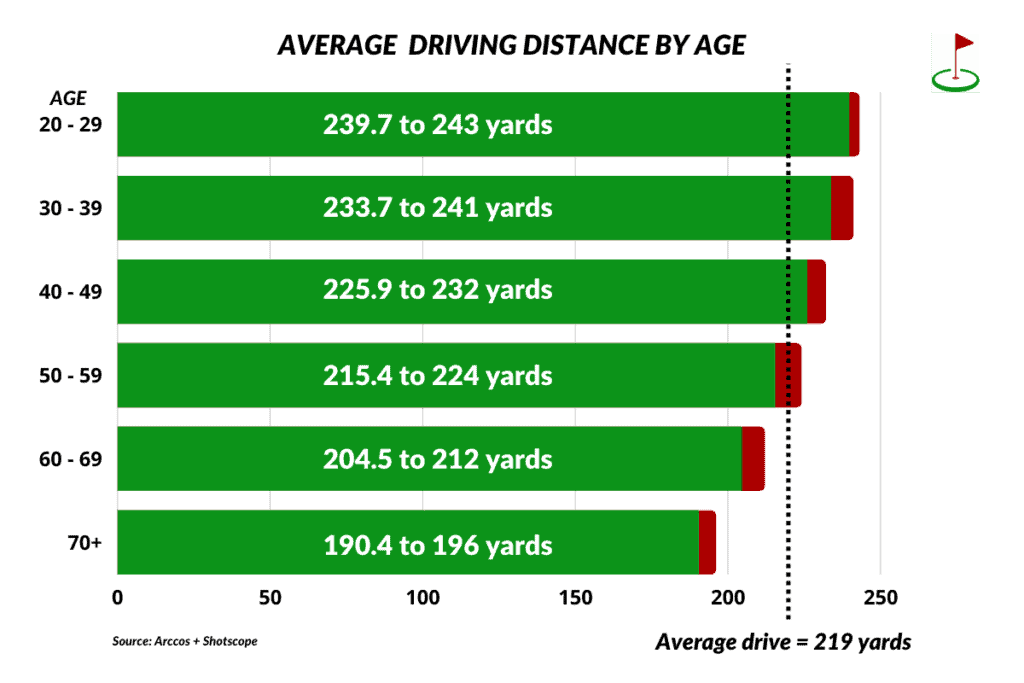
[Editor’s note – Arccos data is also available for the 10 to 19-year-old age group and measures that age group of players hit the ball 234.2 yards on average. Given it is very unlikely that youngsters are achieving those distances this data is likely heavily skewed towards older teenagers and so not included above.]
Average Driving Distance by Handicap
Another category to analyse how far the average golfer should hit a driver is by handicap.
Handicaps are obviously the clearest indication through which amateur golfers can measure their capability compared to their peers and as such it makes sense to compare how driving distances between golfers of different handicaps stack up.
On average golfers with a handicap less than 6 hit a driver a total distance of 239 yards according to the USGA’s Distance Report. Players with a handicap between 6 and 12 drive 219 yards on average while 13 to 20 handicapped players drive an average of 200 yards. 21+ high handicapped golfers average 176 yards with driver.
As can be seen from the graph below golf’s two governing bodies – the United States Golfing Association (USGA) and the Royal & Ancient (R&A) – have been monitoring the distances amateurs hit the golf ball for a long time collecting data back as far back as 1996.
And unsurprisingly they have found a clear correlation between the length golfers drive the ball and their handicaps with better players with better handicaps consistently hitting the ball further than their higher handicapped colleagues.
Over the past 30 years, in particular, there have been huge technical advances in the manufacture of golf equipment – for example, the development of oversized drivers and multi-layered golf balls – which have resulted in both amateur and professional golfers hitting the ball ever increasing distances.
As the USGA’s Distance Report data clearly shows this has resulted in all categories of handicapped amateurs gaining distance with their drivers over the recent decades.
This has allowed the highest handicapped groups to gain significant yards with the distance they hit their driver over the years however other handicap categories have also recorded distance gains therefore maintaining the overall gap in average driving distance between lower and higher handicapped golfers.
When it comes to breaking down driving distance by handicap regular amateurs frequently point out the flaws in categorising how far players hit their driver in this way as almost every golfer knows a high handicapper who breaks the mould and drives the ball as far, if not further than some lower handicapped golfers.
Irrespective of this the general correlation between higher average driving distances and lower handicapped golfers is corroborated by Arccos’ analysis of the millions of shots played by their users.
As can be seen in the graph below the clear majority of Arccos golfers who hit the ball over 240 yards, and therefore find themselves hitting their driver further than 75% of male amateurs, are low single figure handicapped golfers.
This therefore shows that, although there are exceptions to the rule, lower handicapped players hit the ball further than higher handicapped ones and as a result the longer you drive the ball the more likely it is you will have a lower handicap.
How Far Should I Hit My Driver Based on Swingspeed?
One of the key factors in golf over the past couple of decades especially has been the advance in golf tech.
And this has not only had an enormous influence on the drivers that golfers now use and how far they hit them but also on the measures with which players have been able to analyse their performance.
The ability to measure swingspeed and its impact on driving distance has therefore become an ever more important statistic in golf as fancy technical equipment like Trackman, Flightscope and Shotlink has allowed pros and regular amateurs to find out how far they should hit their driver based on their swingspeed.
In total a male amateur golfer with an average swingspeed of 93.4mph hits a driver 214 yards according to Trackman. This equates to approximately 2.29 yards per mph of club head speed. Woman golfers average a swingspeed of 78mph to hit their driver 167 yards on average achieving 2.14 yards per mph of club head speed.
Estimating how far you should hit your driver according to your swingspeed however is not always straight forward as clearly swingspeeds vary each shot as does the quality of the strike on the ball.
Jaacob Bowden, founder of Swing Man Golf and considered to be one of the world’s leading experts on swing speed training, has however been studying pro swingspeed data for years and provides the following estimates as a guide for male amateurs for how far they can expect to hit their driver with their swing speed.
In the table below we have also included relevant benchmarks to enable comparison with the pros.
| SWINGSPEED | AVERAGE TOTAL DRIVER DISTANCE | COMMENTS |
| 60 mph | 139 to 155 yards | |
| 70 mph | 162 to 181 yards | |
| 80 mph | 185 to 206 yards | |
| 90 mph | 208 to 232 yards | |
| 94 mph | 248 yards | LPGA Tour Average |
| 100 mph | 231 to 258 yards | |
| 106 mph | 274 yards | PGA Champions Tour Average |
| 110 mph | 255 to 284 yards | |
| 114 mph | 296.2 yards | PGA Tour Average |
| 120 mph | 278 to 310 yards | |
| 130 mph | 301 to 335 yards | |
| 132.2 mph | 323.7 yards | Bryson DeChambeau |
| 157 mph | 435 yards | World Long Drive Record Holder |
A closer look at this data tells us a couple of things.
Firstly the pros hit the ball further than amateurs not only because they consistently achieve higher swing speeds but also because they have a higher ‘driving efficiency’.
In other words they strike the ball better and much more often around the sweetspot than regular amateur players.
This is most obviously shown when you compare the average male amateur with the average LPGA Tour pro.
While both have very similar swingspeeds – 93.4 mph for the average male amateur vs. a 94 mph average on the LPGA Tour – a women tour pro averages a total distance with a driver of 248 yards compared to 214 yards for the average amateur.
That’s a whopping 34 yards with essentially the same swing speeds and the main reasons for this are swing technique and the quality of ball striking LPGA Tour pros achieve compared to male amateur players.
Indeed with an average driving efficiency of 2.64 yards per mph of clubhead speed there is an argument that LPGA Tour players are on average better ball strikers than their male colleagues on the PGA Tour who achieve 2.59 yards per mph of club head speed by comparison.
“How important is your average golf swing speed? It’s very important. Simply put the more swing speed you have the farther you’ll hit the ball.”
Jaacob Bowden, Senior Writer at GolfWRX, PGA of America Top 100 Most Popular Instructor.
The second and key thing this data tells us however is that it is clear that there is a direct correlation between club head speed and the distance you hit the ball.
Want to increase how far you hit your driver and improvements to your swing technique, ball striking and equipment are only going to get you so far.
In simple terms therefore if you want to hit your drives a lot further you must gain more swing speed.
Final Thought
Alongside the explosion in golf tech in recent years has also come an explosion in the amount of stats available not just to the pros but to regular amateur players as well.
Data from millions of golf shots have now been poured over by statisticians and distinguished professors and this has proven a direct link between your driving distance and your scoring and therefore handicap.
In short it is now crystal clear that if you want to be a better player and score better you need to consistently hit the ball further than you are doing.
So according to the stats any time you spend working on things that help your driving distance is going to be worthwhile when it comes to the most important stats in all of golf – the numbers you write on your scorecard!
[Note – Just so you know, and we are upfront as an affiliate program participant, Golfing Focus, at no cost to you, earns from qualifying purchases made through links on this page.]
More great articles related to this topic:
- Why Don’t Your Drives Go Far? Slow and Steady Loses the Race
- What Determines Driver Distance? Skill Triumphs Over All!
- 10 Ways to Get More Distance off The Tee With & Without Speed!
- Average Driver Swingspeeds? COMPLETE GUIDE by Age, Handicap etc.
- Ideal Spin Rate and Launch Angle for Driver? That’s Personal!
- How Far Should Your Ball Speed Go? 100mph All the Way to 210mph!
- How Far Should Your Driver Swingspeed Go? 60 to 120 mph Guide
- What Should Your Driver Attack Angle Be? Try Not to Be Negative
- How Much Does Driver Loft Affect Distance? Loft is Dynamic Too!
- Where is the Sweet Spot on the Driver Face? Take the High Road
- Are Driving Range Distances Accurate? Golf Balls are a Problem
- Should Beginners & High Handicappers Use a Driver? Yes & Yes
- How Far Should You Hit Your Wedges? Be Sure to Fill the Gaps!
- How Far Should I Hit My Irons? By Handicap, Age & Swingspeed
- How Far Should I Hit My Hybrids? 2 vs 3 vs 4 Hybrid Distances
- How Far Does a 3 Wood vs 5 Wood Go? Tee and Approach Shots!
- Do Distance Balls Go Further? Marketing Matters
- Do All Golf Balls Go the Same Distance? Physics First
- What is Considered a Long Golf Course? The Long and Short of It
- What Driver is Most Used On the PGA Tour? Top 100 Player Analysis
- How Do Pros Hit the Ball So Far? It’s Not About the Equipment!
- How Far Do Pro Golfers Hit Each Club?
- The PGA Tour’s Rising Driver Ball Speeds Mean One Thing – $$
- Most Popular Driver on LPGA Tour? Top 50 Player Guide
RECENT ARTICLES
LEGAL INFORMATION
This site is owned and operated by Golfing Focus Limited, a private limited company whose registered office is in London, UK. Golfing Focus Limited is a participant in the Amazon Services LLC Associates Program, an affiliate advertising program designed to provide a means for sites to earn advertising fees (at no cost to you) by linking to Amazon.com. Golfing Focus Limited also participates in other affiliate programs with the eBay Partner Network, FlexOffers, CJ.com, Svorn and other sites and is compensated for referring traffic and business to these companies (again at no cost to you).
Our Socials

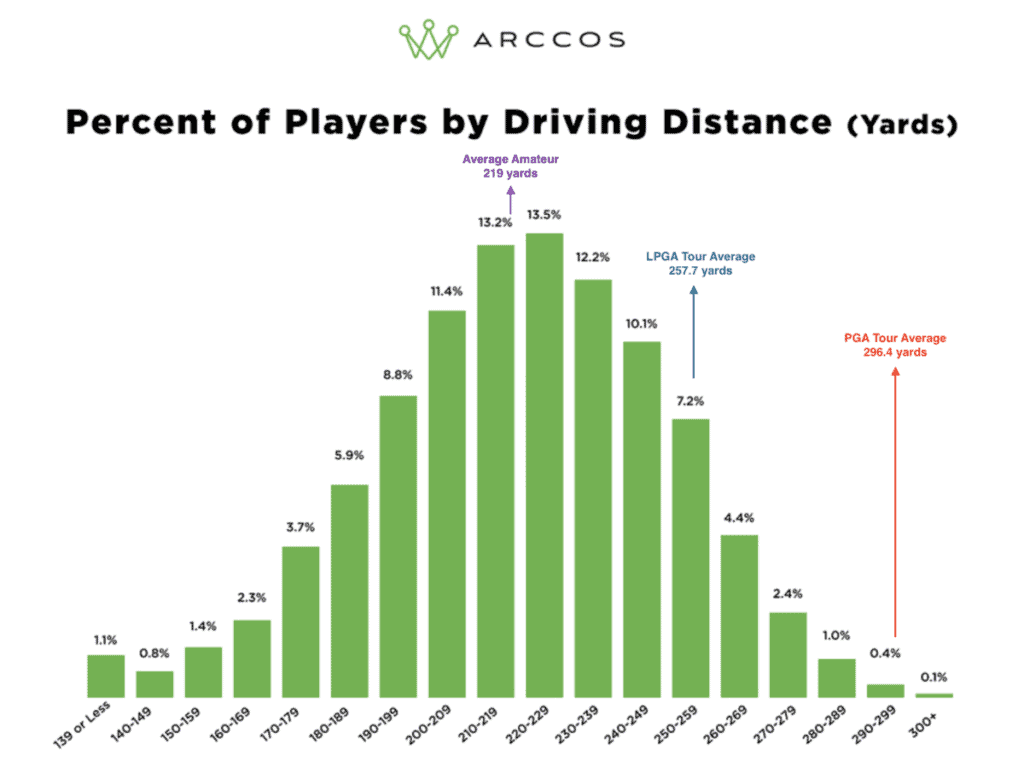


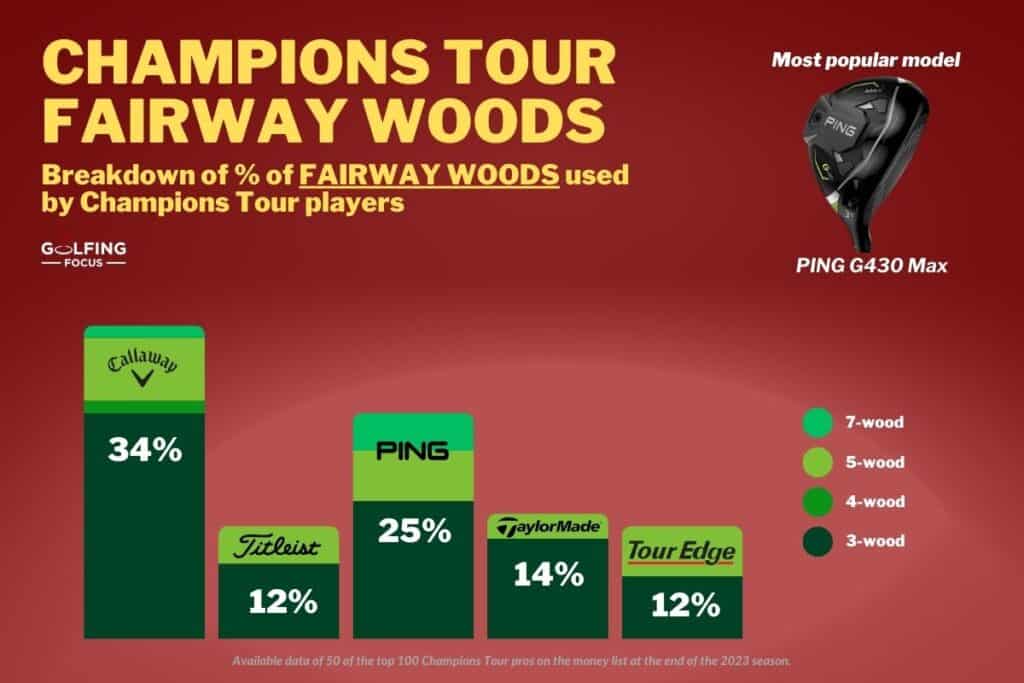
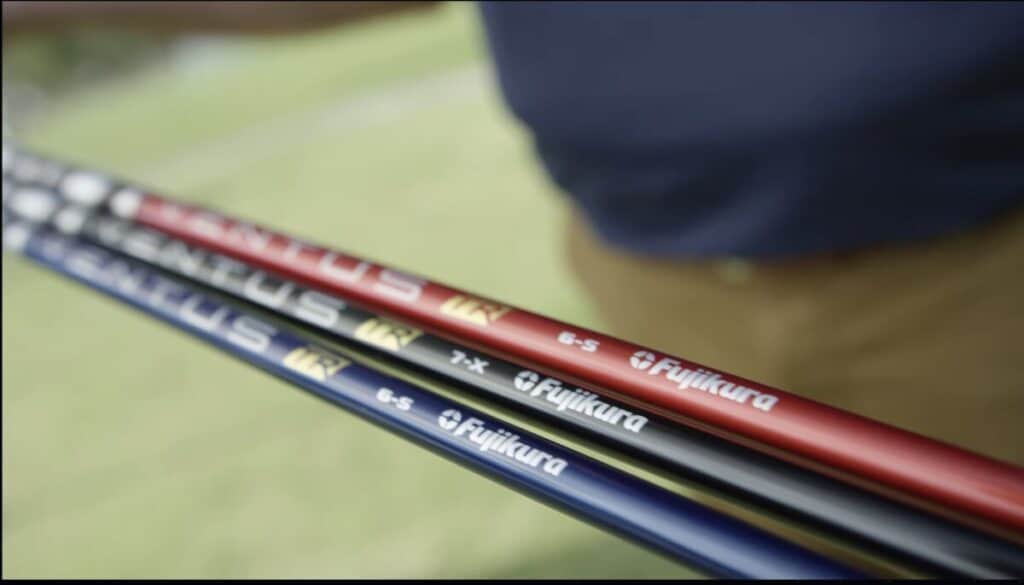
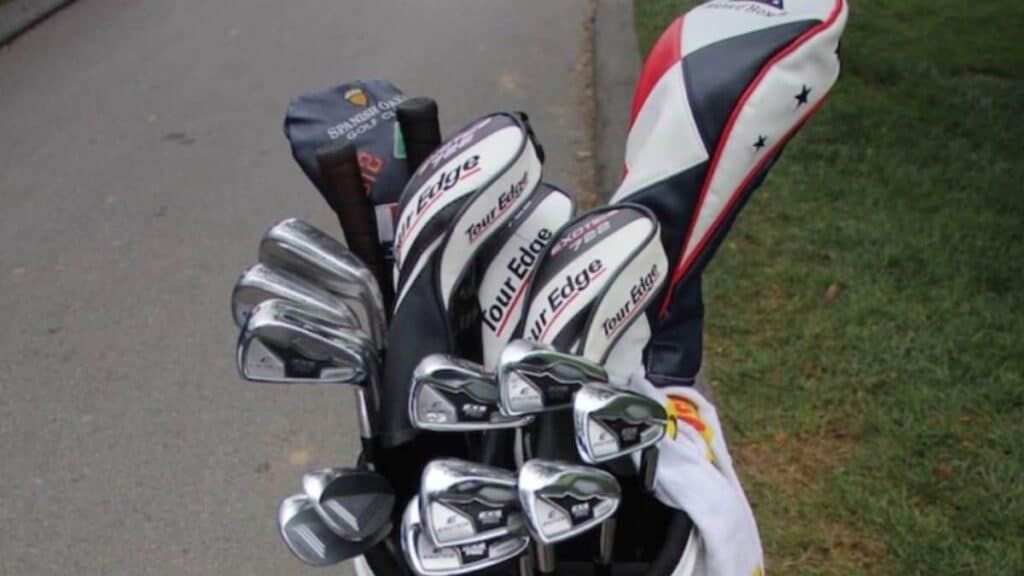
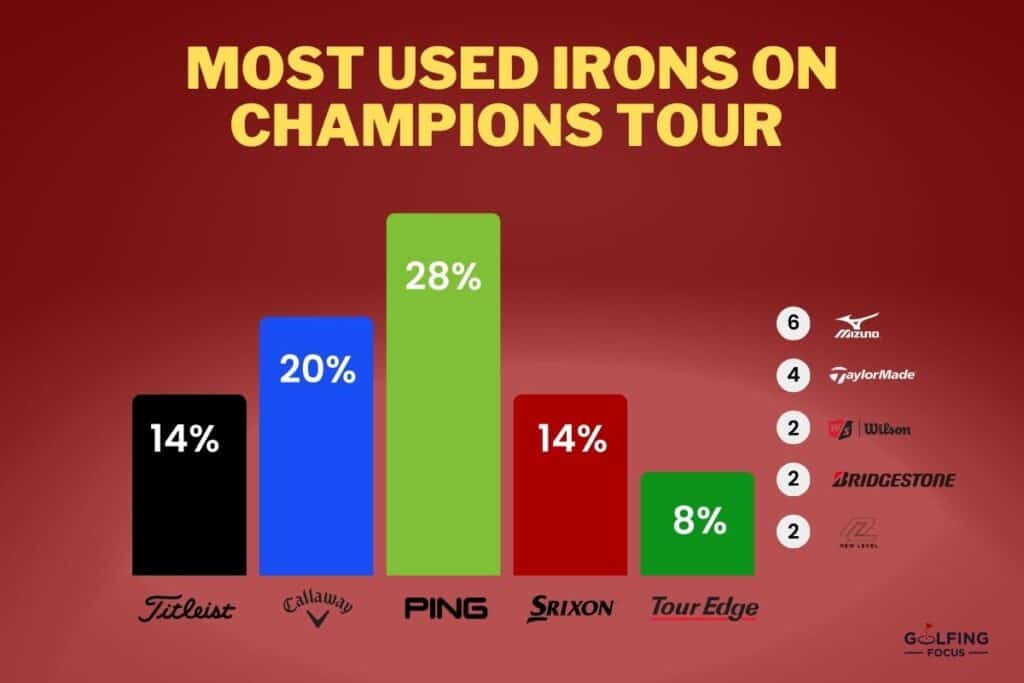
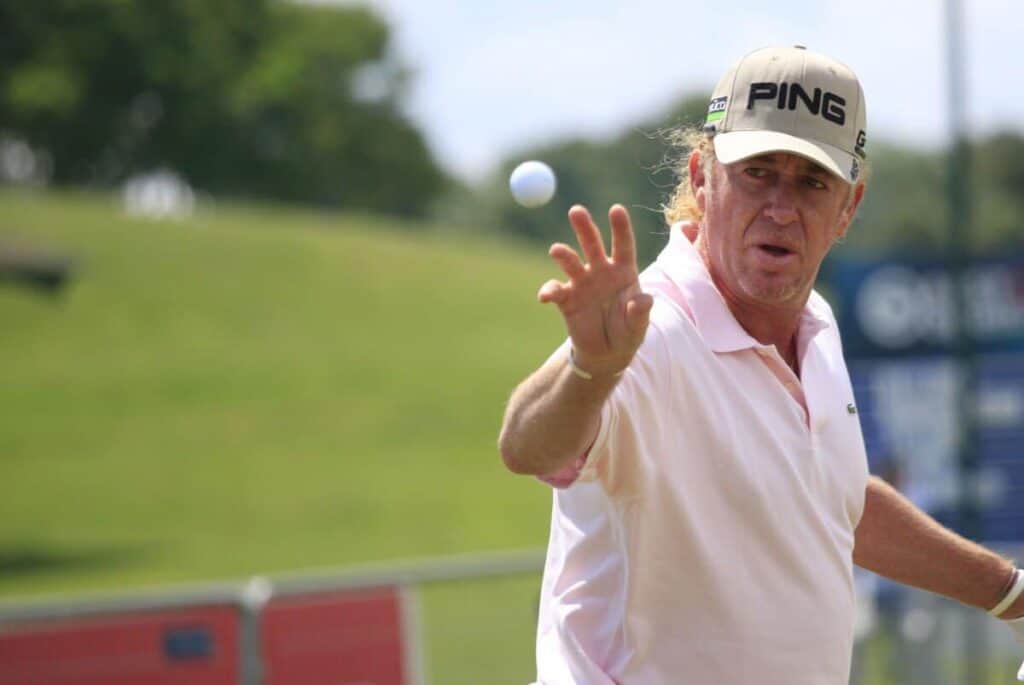
Leave a Reply